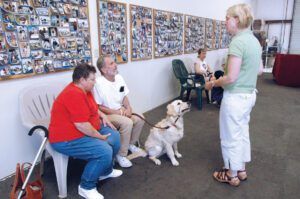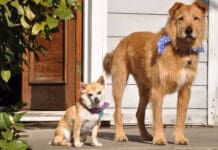I’ve paid to take group dog-training classes a number of times – even though I know how to and am even pretty good at training my own and other people’s dogs.
I have had slightly different reasons for wanting to take classes with each of my three dogs.
When I adopted Otto in June 2008, he was about 7 months old, but I signed up for some basic training classes to update my own timing and coordination skills so I could best communicate with my adolescent dog who had an uncertain origin. He had some quirks and fears and I wanted to make sure that I was doing everything right to gain his trust and want to work with me.
In later years, I signed us up for some agility classes; I thought I might try to take Otto to an agility competition someday, though we never did do that. Otto enjoyed the running around and negotiating the various obstacles, and he was so happy doing it, that it was sheer fun for me, too.
When I adopted Woody in January 2016, he was just a little pup, 9 or 10 weeks old. But I knew he was going to be a big, strong dog with a bully-breed look, and I wanted to make sure that I super-socialized him and trained him to be very compliant in any setting. I didn’t want people to judge him or be afraid of him based on his looks; I also wanted him to learn to behave well and pay attention to me when there were other dogs present. We took six-week Puppy 1 and then Puppy 2 courses, and later, also took some introductory agility courses.
Partly due to the limited class offerings because of Covid, and partly because I was hemming and hawing for months and months over whether to keep my youngest dog, Boone, whom I had started fostering when he was just about 6 or 8 weeks old, I never signed him up for puppy classes. When I finally got around to signing us up for an adolescent class, I was horrified to see how high-strung he was in class. He could focus on me very well, but it required some effort on his part. Instead of taking treats nicely like he can at home or when we are out walking, he lunged and grabbed for them in a frantic way that revealed his tension in the group-class setting. He needs a lot more practice and classes to learn to relax in a group setting.
Dog-training classes can be expensive, especially if they take place in a pleasant, spacious, climate-controlled location with safe footing. But classes are one thing I am always happy to pay for; I think of them as an investment in my relationship and good communication with my dogs, their good behavior anywhere I take them, and their own comfort and safety in public. I want them to be confident, secure, and well-mannered wherever we find ourselves, whether it’s a hotel we’ve had to stay in because we’ve been evacuated due to a wildfire or a friend’s home we’re visiting for the weekend. And I don’t want anyone dreading our arrival, worried about their carpets or cats or kids!
Classes are not just for puppies or problematic behavior
However, unless someone has a new puppy, or a dog with a vexing behavior that is causing problems for the human family, most dog owners don’t take dog-training classes! I wish there was some data about how many dog owners pay for any sort of dog training; I’m not aware of any organization that keeps these statistics (if you’re aware of some, please let me know!). My own experience is that very few people do.
And, given my job, I am often asked by friends or family about their dogs’ behavior issues – separation anxiety, reactivity on leash, pulling on leash, excessive barking, and so on. No matter what the question is, I always recommend consulting a local trainer and/or taking a basic training class. And nearly always, the response is, “No, we don’t need a class, it’s just this one problem we’re having.” But in my view, if my friends or family members knew even just a little bit more about training, not only would the problem behavior improve, their entire relationship with the dog would improve, too.
I think of a basic group training class as the equivalent of a high school speech class; it’s where you learn to communicate in a clear and effective way, instead of shouting nonsensically at others, arguing with people ineffectively, and failing to get your needs met. A single multiple-week course would help anyone get to know and understand their dog better and communicate with the dog better, which would likely help the dog understand what the heck is expected of him better, too – which would surely relieve some of the anxiety that’s likely driving some of his problematic behavior!
So many owners seem to have the expectation that their dogs should understand conversational English by the age of 4 or 5 months and somehow just know how to behave calmly in any setting. And most people manage to teach their dogs a few basics: sit (usually), come (sometimes), and walk on a leash (sort of). But if you ask the average dog owner how they would teach a dog to perform a specific skill on cue – and you made that skill something that the average dog owner does not expect their dog to know, say, pushing a ball with their nose into a soccer goal, or “waving” a front paw in the air – few people would know how to systematically shape that behavior using well-timed markers and rewards. In my opinion, once you’ve learned the basic steps to and mechanics of teaching a dog to perform any behavior on cue, you should be able to teach them any other behavior. And that’s what basic training classes are for!
Anyway, I’m curious about our readers: Have you taken any classes with your current dogs? If so, what classes did you take or are you taking? And if not, why haven’t you?







We have taken puppy classes with each of our three Berners. Each dog is different, and learning to work with one dog does not meat the same lessons apply to the next one. Puppy classes don’t so much train the dogs as they do the humans, and we have had to work a bit differently with each dog. I am grateful for the support and reassurance that comes with a confident instructor and a network of owners facing the same set of issues. Classes are both learning experience AND support group for puppy owners. Just like babies, it helps a lot to know you are not the only one!
I’ve trained my own dogs, and I’ve been a dog training instructor, and I’ve shown in obedience with great success, all since 1958. Yet, every time I start a puppy, we go to obedience classes together. The puppy needs the experience of working in a group of dogs and people and I need to keep up on new ideas and trends in dog training. The greatest difficulty we have is finding instructors and groups that appreciate an experienced trainer as a classmate!
My seven month old Golden Retriever was so confused with all the dogs in the class (six), he is very high strung and high anxiety; thought we were there to play. The instructor had to take him separately to do the things she wanted done and he would it but when returned to the circle, got so excited. I do believe in a situation like ours one on one training would have been better at first. Our vet has never seen a GR like him and doesn’t expect him to settle down until around four years old.
I train my own dgs as a training instructor, however, I try to get us into classes. One reason is it gives me specific times to work with the newest dog in my household. Or to refresh know cues. I call it “mommy and me time”. I only have the one dog who gets individualized attention without all the other chaos at home. I get to really work on the bond with just that dog and I am not being interrupted by my phone, the doorbell or other dogs. I find it a win win situation for me and my dogs.
I train my own dogs but would love to attend classes. It keeps me honest and consistent. But I’m mostly deaf and it’s impossible to hear what the instructor is saying. I can observe body language and lip read well enough to follow along but I’m missing the “why” we’re doing a specific exercise. Private instructions are excellent but expensive. I think a good solution would be for the instructor to use a smartphone and microphone (or ear buds) and set up a group phone call. Attendees can call in using their phones and headsets (my headset is adjusted to compensate for my hearing loss). Attendees with normal hearing probably won’t need to use this option.
We have had four GSDs over 37 years, often two at the same time. They were all puppies when we got them & they were trained by us & then through various training classes. They were well behaved adults who had been with groups of dogs without any issues. The trainers then seemed to be similar, along the lines of basic leash training, praising the dog, hand commands, getting all members of large groups to walk around together & socialize. Effective. Nearly two years ago we adopted Rafa, a rescue GSD who is a miracle. He (just over a year then) had had basics but we embarked on training courses. There were no large group efforts, just staying in place while other dogs walked, displaying the lessons. Small groups, very expensive – we tried 3 different trainers, all similar, using base mats, no real commands, loads of treats, went on for many weeks w/little improvement by anyone. After many such sessions, I still am working those methods but need the interaction w/other owners & dogs. It was a waste of money (COVID hasn’t helped these classes) & I walk/jogwith Rafa every a.m. – his reactions to humans is fine but he sometimes STILL lunges toward other dogs. Tail wagging. Because we don’t know his past, I try to get him to sit (another negative as he is very strong & other owners don’t seem to be able to hold their dogs or walk by calmly). I’ve read every behavioral book, tried many methods, & my husband does the same. I use markers, he performs exquisitely at home but then we go to a park or busy area & he’s totally absorbed by everything around him. If I could a trainer who could acknowledge our needing to have more controlled group interaction (which we – & OTHERS in each class requested), we could socialize him – something that, around dogs, he lacked. He does improve but it is slow going & other than that, he’s the perfect dog. I just want him to have fun with some other dogs but the trainers kept everyone apart (not just because he’s a GSD; they did this with everyone & if we even got close to another dog, the trainer had us all get back to our mats). It was frustrating. I have a friend w/similar issues so we’re hoping to get together with the dogs (he’s a GSD too & was trained several times in Germany but also pulls on a leash) & work this out at least with the two of them. Thanks for the article – I just feel that I’ve failed my beautiful boy & want him to be happy.
As a young couple just starting out, my husband and I were eager to get a dog. As a dog lovers and growing up with dogs, we both had some ideas about training and did fairly well bringing up our first puppy. Classes never even occurred to me. That pup lived 15 years. When she passed we had four young children and although I missed having a dog, I was not anxious to raise another baby while raising for four young humans. After taking a few years off, we decided to look for an older dog needing a home. After some searching, a 6 year old German Shepherd/Collie mix landed in our laps. Again, taking classes never occurred to me. He was already a pretty well mannered dog although he had experienced some trauma and abuse, he was a kind, loving soul. We had him 8 years and he has been the best dog I ever had the privilege of living with. He was loved by us all and all of those who knew him. When we lost him, I was anxious to have another dog and we adopted another dog. This dog had a great deal of baggage. It was apparent early on we needed help. We began classes and professional training immediately. We did improve substantially but his aggressive tendencies remained challenging. He would bite us and others. I could never fully find/understand his triggers and ultimately after one year decided to return him to the rescue organization we adopted him from. This was traumatic especially for me and I felt like a failure. It took about a year but I started looking for another dog. This time a young puppy from the local Humane Society fell into our laps. I started classes immediately. This pup is a doll and although, like any dog, she has some quirks, classes have helped both of us tremendously. She is on the timid side and at the recommendation of an instructor, we also started some agility classes in addition to obedience work. Together we have a ball and I believe classes are helping her feel more confident in her own skin! I now recommend classes and professional training to anyone with a new dog in their household.
We adopted an 11 year old cockapoo…. We lucked out…. He is a sweetheart but just because I always take my dogs to classes for the bond and social exposure it offers , I took him also. He did really well and now has his CGC. I always recommend classes of any kind to anyone who gets a new dog …. no matter the age . It’s never too late to have fun together !
I’ve had dogs for years and years. Most of the time I have taken classes when I’ve gotten a new dog. Because I’ve had dogs for so many years, some of the training styles have changed, and it’s fun to know the latest and greatest. I’ve also used a Trainer. My dogs have become delightful, and have blossomed through this process. Even a couple of reactive dogs. I was working with the trainer to see if I could get a reactive dog to go for walks with the group. I decided in his heart he really didn’t want to be around other dogs. He hated the dog park. But I was able to get him to be able to walked by other dogs, I learned to give distance to make him comfortable, and we had a very happy life together. I have adjusted my life with my dogs. My dog that liked being on his own, I listen to audiobooks. Now I have a puppy that likes playing with other dogs and i don’t listen to audiobooks when we go out. We get to go to an off leash, dog park and play with other dogs and people. I think it’s really important to get a trainer that loves dogs.
For my first dog, a Bouvier, I took puppy classes, then I took Freestyle classes for 3 years and actually competed earning our Championship. Meanwhile I took every dog training class or workshop available including Karen Pryor’s Clicker Expo a few times. I skipped the puppy classes for my next dog, a Standard Poodle, because I had a pretty good understanding of how to train him. Big mistake because he didn’t get that socialization from the class. Also, he can be reactive so it’s more difficult to take him places. I have taken many Fenzi on line classes. My next Standard Poodle went directly to puppy classes again and lots of Fenzi classes again. I’ve fallen off the training wagon but just today took a FaceTime class which was very motivating!
I think exactly as you do , Nancy! I love to continue to learn and update my skills as a dog trainer. It greatly benefits our bond and believe me after 10 dogs and lots of competition , my new dog , a Goldendoodle 12 mos old is the greatest challenge yet! I enjoy the work and environment. I will need this latest training operation to support me with this new dog.
My husband and I have had many dogs over the years, and I’ve basically trained them at home on my own on basics, such as place, come, sit, etc. Now I’m taking my two- year old toy poodle, Polly, to private training right now. I also have two rescue Maltese and I’ve taken one of them to training, too. I personally think a lot of the success is based on the trainer (how you and the dog bond with the trainer) and the methods used. I’m lucky enough to have a fabulous trainer now. And a fabulous little toy poodle. I love going to class with her and watching her blossom as we strengthen our bond. I would definitely recommend at least basic training for any dog.